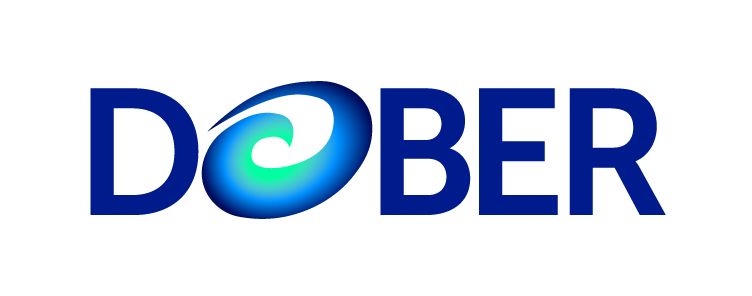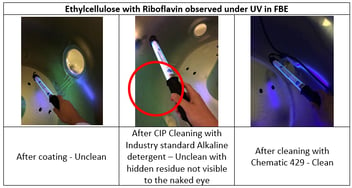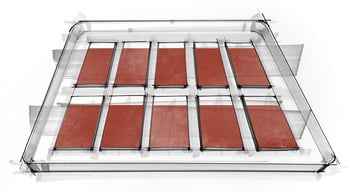Sustained Release Polymers - Field Story

When I first joined the Technical Service department in my Pharmaceutical career, I imagined that I would amass scientific know-how and find technical solutions to the manufacturing issues. But now, I can assure you, that is just a small part. What I mainly learned was the importance of communication skills, patience, and perseverance. I discovered that we need to primarily find a solution to get all the parties involved to agree. Facilitating discussions until a consensus is achieved was my unwritten job description. The legendary conflict between different pharmaceutical departments is a little more than a myth and the only way that the well-reasoned technical solution to the actual problem can be applied is if all are convinced about its merits.
Their Operation Excellence team realized that by decreasing cleaning downtime with Chematic®, they could easily free up capacity and manufacture more.
Recently, when I attended a cleaning trial, I was reminded of this. This trial was in a country, whose language I cannot speak nor understand (this information is significant to my story). I had discussed the cleaning procedure of Eudragit® RL 30 D coating with Chematic® RL/RS. This Sustained Release polymer was used for the coating of a legacy product, but the demand had gone up lately and they needed to increase the production capacity of the coating equipment. Their Operation Excellence team realized that by decreasing cleaning downtime with Chematic®, they could easily free up capacity and manufacture more.
Before any trial at a production facility, I make sure that the technical team is aware of how Chematic® works with their residue. The sole reason for me explaining ‘The Science behind Cleaning’ is to empower them with a basic understanding and enable them to optimize the cleaning procedure, at the same time helping them apply Chematic® to variants of the targeted residues in different equipment. I usually outline the procedure & precautions and let them know what to expect at different time-points of the trial, especially for manual cleaning where there is a high possibility of deviation from person to person. However, due to my poor language skills, I could convey all that I wanted to only to the smart & young English-speaking Tech-transfer manager.
When we started the cleaning, we filled the coating pan with the diluted Chematic® RL/RS solution and I asked for the pan rotation to be started to enable soaking of the pan, perforations, and baffles. The Tech-transfer manager translated this to the much older and experienced operator, who, to my surprise, ignored the instruction, said something in their language that sounded like a good-natured banter, got into the pan with a nylon brush & started scrubbing! The whole point of changing their current cleaning procedure was to eliminate the time-consuming manual scrubbing by using the customized Chematic® chemistry, and this could easily be achieved by the fill-soak & agitation process that was originally planned. The Tech-transfer manager tried explaining the recommended process to the operator a few more times, but the operator just waved him off, looked at me, smilingly flexed his biceps under the layers of PPEs, chattering away all the time (I obviously couldn’t understand a word of what he was saying). When I asked the Tech-transfer manager what was happening, he embarrassingly told me that the operator was cleaning this product for the last 20 years and knew no other way of getting it off the equipment without heavy scrubbing, which he jokingly said, could be done better by a strong person like him (so that’s what the bicep flexing was all about!). As the operator didn’t report to the Tech transfer manager and believed him to be young & inexperienced in the field of cleaning, he didn’t feel obliged to follow the given orders. Old habits die hard and it was impossible to get him to stop doing the task he had undertaken.
There was nothing left to scrub as Chematic® RL/RS had dissolved the soaked residue which was nearly impossible to scrub off
After about 30 minutes, when he was finally tired of scrubbing one area and rotated the pan to clean the section that was left soaking in the detergent solution, he was in for a shock! There was nothing left to scrub as Chematic® RL/RS had dissolved the soaked residue which was nearly impossible to scrub off. I expected this result, but not his reaction. Getting into my professional mode, I tried to maintain a passive expression, but couldn’t help smiling when the Tech-transfer manager, and after a few moments, the operator, burst out laughing.
It was then that the operator heard what the manager had to say. He was very impressed with Chematic® and didn’t understand why he was scrubbing for the last 20 years when the Eudragit® RL 30 D polymer could be cleaned this easily. His endorsement meant a lot to me and it was a great feeling to relieve that man from the back-breaking job and see him satisfied.
I wish we had communicated well with the shopfloor team before the trial and taken them into confidence, although breaking a 20-year-old habit is not easy, and it is highly possible that the events would be no different than the way they actually played out, even if we had done an operator training. And if it did, I wouldn’t have this story to tell!



